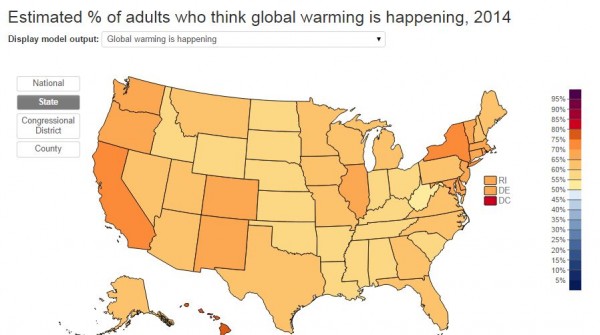Climate Change Beliefs in U.S. Depend on the State Where You Live
| Marco Foronda | | Apr 07, 2015 11:15 AM EDT |
(Photo : Yale) Interactive global warming map from Yale
The majority of Americans, or 63 percent, believe global warming is occurring and almost half of it is being caused by human activities.
Researchers at Yale University released an interactive map showing detailed differences in public perception about global warming on a national, state, congressional district and county level.
Like Us on Facebook
The data used to create the seven maps were from 12 surveys conducted between 2008 and 2013 by the Yale Project on Climate Communication and the George Mason Center for Climate Change Communication. Researchers used it to make their projections and compare the results to state and local surveys.
They surveyed participants in all 50 states, including 435 Congressional districts, 3,000 counties, and 381 cities. Researchers compiled their data into a set of interactive maps that can be found at http://environment.yale.edu/poe/v2014.
Collectively, 63 percent of Americans were found to believe global warming but those numbers ranged from a low of 54 percent in coal-friendly West Virginia to 81 percent in Washington, D.C. Citizens in Hawaii, New York and California are the next biggest believers at 75 percent, 72 percent and 70 percent, respectively. Lowest numbers generally were found in Middle America and in parts of the Southeast, areas where the Republican Party is strong.
When it comes to policy support, the majority of Americans surveyed believe government should allocate more funds to renewable energy sources and regulate carbon dioxide by setting limits on coal-fired power plants.
"These differences are partly due to the fact that different groups often think differently about the issue," said study lead author Peter Howe of Utah State University.
Researchers clarified that the interactive maps show estimates of public opinion and that more research is needed to determine accuracy.
TagsClimate Change Beliefs Vary Depend on the State You Live, climate change. global warming, americans, renewable energy sources
©2015 Chinatopix All rights reserved. Do not reproduce without permission
EDITOR'S PICKS
-

Did the Trump administration just announce plans for a trade war with ‘hostile’ China and Russia?
-

US Senate passes Taiwan travel bill slammed by China
-

As Yan Sihong’s family grieves, here are other Chinese students who went missing abroad. Some have never been found
-

Beijing blasts Western critics who ‘smear China’ with the term sharp power
-

China Envoy Seeks to Defuse Tensions With U.S. as a Trade War Brews
-

Singapore's Deputy PM Provides Bitcoin Vote of Confidence Amid China's Blanket Bans
-

China warns investors over risks in overseas virtual currency trading
-

Chinese government most trustworthy: survey
-

Kashima Antlers On Course For Back-To-Back Titles
MOST POPULAR
LATEST NEWS
Zhou Yongkang: China's Former Security Chief Sentenced to Life in Prison

China's former Chief of the Ministry of Public Security, Zhou Yongkang, has been given a life sentence after he was found guilty of abusing his office, bribery and deliberately ... Full Article
TRENDING STORY

China Pork Prices Expected to Stabilize As The Supplies Recover

Elephone P9000 Smartphone is now on Sale on Amazon India

There's a Big Chance Cliffhangers Won't Still Be Resolved When Grey's Anatomy Season 13 Returns

Supreme Court Ruled on Samsung vs Apple Dispute for Patent Infringement

Microsoft Surface Pro 5 Rumors and Release Date: What is the Latest?










